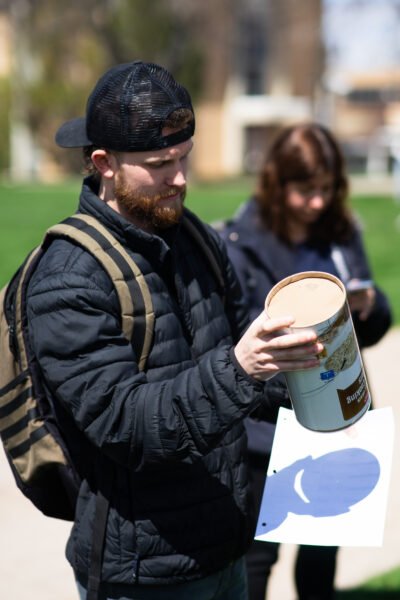Partial solar eclipse gives Logan an astronomical show
A partial total eclipse gave Utah State an astronomical show on Monday, April 8. Dozens of individuals gathered on the Quad to learn more about the eclipse, watch the moon’s progression over the sun through solar glasses and partake in astrophotography.
The last eclipse in Logan was on Oct. 14, 2023. It was annular, which means the moon didn’t completely cover the sun, and a “ring of fire” was left shining through.
This eclipse was total. Those in the line of totality witnessed the moon completely cover the sun, leaving the corona to be safely viewed without eye protection for a few minutes. Logan experienced almost 50% coverage of the sun.
Blake Fuller, a first-year student studying economics, had a line of interested spectators waiting to view the eclipse through his solar-filtered camera.
“I like sharing my hobbies with people and letting people view stuff that they can’t view with the naked eye,” Fuller said. “Being able to help people see this cool stuff is great.”
According to Fuller, there were several sunspots visible during the eclipse that could be seen through the cameras. Sunspots are regions on the sun’s surface that appear darker because they are cooler in comparison. They are generally thought to be caused by changes in the sun’s magnetic field.
“Being aware of what’s actually around us is really fun, and being able to enjoy nature,” Fuller said. “People getting together for big events like this is getting us closer to people, which is good.”
Though astrophotography equipment can be expensive, Fuller said the money he spends is worth the images he captures.
“EBay is magical and cheap for college students,” Fuller said. “I’m glad I skipped class.”
Ethan Verdoorn watched with a homemade pinhole projector to view the eclipse without solar glasses.
“This is a tube with a little pinhole in it, and you shine it directly into the sun, and you’re actually able to see the different phases of the eclipse,” Verdoorn said. “You can save your eyes and still be able to see it.”
Students used anything from cardboard, paper, tubes and their own hands to safely view the sun’s coverage on the sidewalk or a sheet of paper. This also works with the spaces between shadows from leaves or household items like strainers.

Ethan Verdoorn poses on the Quad with his pinhole projector during the eclipse on April 8.
Verdoorn said he was especially excited about the eclipse because his dad is a meteorologist who taught him about astronomy.
“It’s really awesome that people can get together and experience it and enjoy it together,” Verdoorn said.
For students who didn’t have access to solar filters, some creativity was required to make working projectors.
Ellie Carpenter, a junior studying plant science, took a more artistic approach to the pinhole projection method of viewing.
“I poked a bunch of holes in it in a smiley face shape,” Carpenter said. “When the light goes through it, you can see the shape of the eclipse in all the little holes. I didn’t have my eclipse glasses, so this is a very low-tech solution.”
Natalie Arnesen, a junior studying social work, was excited to spend time with friends on the Quad for a rare event in the cosmos.
“We’re lucky that we’ve been living in the generation where there’s actually been so many eclipses in our lifetime,” Arnesen said.
Arnesen said the cameras gave students a better close-up version of the sun than the solar glasses could.
“I like the cameras because they’re kind of zoomed in, so you can see it closer up,” Arnesen said. “If you use the glasses, it’s the same picture, but it’s further away.”
According to Arnesen, it is valuable to be educated on the science behind events like these and not believe false conspiracies.
“It’s important when cool things happen like this, that we can come and meet with people who know more about it, so they can explain it to us, so that we’re kind of educated instead of making crazy claims about what’s going on,” Arnesen said.
The next solar eclipse in Utah will be in over 20 years: A total eclipse in 2045.
“It’s not going to happen for a while longer from now,” Arnesen said. “It’s been cool to be able to come out and be able to look at it.”

